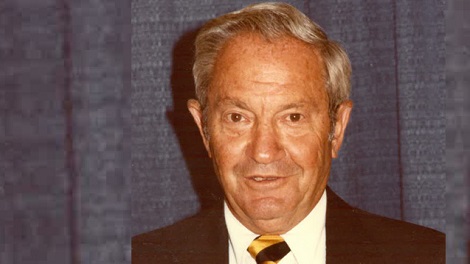USBC Hall of Fame member Milt Rudo dies at age 98
July 10, 2017

ARLINGTON, Texas – Milt Rudo of Chicago, a United States Bowling Congress Hall of Fame member, died July 4. He was 98.
Rudo, who worked for more than four decades with Brunswick Corporation, was elected to the USBC Hall of Fame in 1984 for Meritorious Service for his efforts in the promotion and development of the sport.
Born Jan. 17, 1919, Rudo got his start in bowling when he worked as a laborer constructing bowling lanes in 1938, between his sophomore and junior years at Johns Hopkins University. His father was a branch manager for Brunswick at the time, and Milt was hired by the company after his graduation.
Starting as a salesman in 1940, he eventually would become the Bowling and Billiard Merchandise Manager. During this time, he helped in the redesign of the bowler’s service equipment, taking the chalk and hand towel out of the approach area in order to speed up play.
He became Eastern Regional Sales Manager in 1955 and played a role in the site selection for the first Brunswick Automatic Pinsetter location. He returned to Chicago in 1958 to become general sales manager of the Bowling Division and was heavily involved in the promotion of the sport and was named marketing vice president in 1960.
During this time, he was involved with having the American Bowling Congress accept the use of laminated pins in its tournament and in changing the settee areas from spectator-style seating to a table arrangement.
He was named president of the Bowling Division in 1962 and then selected to head the new Bowling Center Operations Division in 1965. In 1967, Brunswick introduced its automatic scorer with the first fully automated bowling center. Though in development for many years, Rudo’s interest in pioneering the development of the automatic scorer brought a new dimension to bowling.
He later was involved in getting the American Junior Bowling Congress under the administration of ABC and the Women’s International Bowling Congress, and the expansion of the sport in Japan.
He was honored by the Bowling and Billiard Institute of America (BBIA) with the BBIA Industry Service Award in 1973.
In 1979, he was made an honorary member of the Professional Bowlers Association, becoming the first bowling manufacturer representative to receive the honor.
He served six terms as president of the National Bowling Hall of Fame and Museum, overseeing the development and opening of the facility in St. Louis in 1984.
Rudo, who worked for more than four decades with Brunswick Corporation, was elected to the USBC Hall of Fame in 1984 for Meritorious Service for his efforts in the promotion and development of the sport.
Born Jan. 17, 1919, Rudo got his start in bowling when he worked as a laborer constructing bowling lanes in 1938, between his sophomore and junior years at Johns Hopkins University. His father was a branch manager for Brunswick at the time, and Milt was hired by the company after his graduation.
Starting as a salesman in 1940, he eventually would become the Bowling and Billiard Merchandise Manager. During this time, he helped in the redesign of the bowler’s service equipment, taking the chalk and hand towel out of the approach area in order to speed up play.
He became Eastern Regional Sales Manager in 1955 and played a role in the site selection for the first Brunswick Automatic Pinsetter location. He returned to Chicago in 1958 to become general sales manager of the Bowling Division and was heavily involved in the promotion of the sport and was named marketing vice president in 1960.
During this time, he was involved with having the American Bowling Congress accept the use of laminated pins in its tournament and in changing the settee areas from spectator-style seating to a table arrangement.
He was named president of the Bowling Division in 1962 and then selected to head the new Bowling Center Operations Division in 1965. In 1967, Brunswick introduced its automatic scorer with the first fully automated bowling center. Though in development for many years, Rudo’s interest in pioneering the development of the automatic scorer brought a new dimension to bowling.
He later was involved in getting the American Junior Bowling Congress under the administration of ABC and the Women’s International Bowling Congress, and the expansion of the sport in Japan.
He was honored by the Bowling and Billiard Institute of America (BBIA) with the BBIA Industry Service Award in 1973.
In 1979, he was made an honorary member of the Professional Bowlers Association, becoming the first bowling manufacturer representative to receive the honor.
He served six terms as president of the National Bowling Hall of Fame and Museum, overseeing the development and opening of the facility in St. Louis in 1984.





